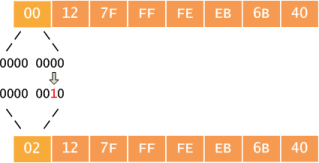Windows by default comes up with a randomly picked IPv6 Link Local address instead of using the EUI-64 version. In a home network it doesn't make sense to apply this fix. This is done just for lab or business setup where you need a static address for authentication.

So, here's how to make Windows behave as per every other OS…
- (EUI-64) format. Since most interfaces still use the 48-bit MAC address, the MAC must be converted into the EUI-64 format. Consider the following MAC address: 1111.2222.3333. The first 24 bits, the Organizationally Unique Identifier (OUI), identify the manufacturer. The last 24 bits uniquely identify the host. To convert this to EUI-64 format: 1.
- The standard (IEEE 802) format for printing EUI-48 addresses in human-friendly form is six groups of two hexadecimal digits, separated by hyphens (-) in transmission order (e.g. This form is also commonly used for EUI-64 (e.g.
- IPv6 EUI-64 calculation The second part of an IPv6 unicast address (used to identify a host's network interface) is usually a 64-bit interface identifier. An interface ID is created by inserting the hex number FFFE in the middle of the MAC address of the network card. Also, the 7th bit in the first byte is flipped to a binary 1.
Eui 64 Address Format

So, here's how to make Windows behave as per every other OS…
- (EUI-64) format. Since most interfaces still use the 48-bit MAC address, the MAC must be converted into the EUI-64 format. Consider the following MAC address: 1111.2222.3333. The first 24 bits, the Organizationally Unique Identifier (OUI), identify the manufacturer. The last 24 bits uniquely identify the host. To convert this to EUI-64 format: 1.
- The standard (IEEE 802) format for printing EUI-48 addresses in human-friendly form is six groups of two hexadecimal digits, separated by hyphens (-) in transmission order (e.g. This form is also commonly used for EUI-64 (e.g.
- IPv6 EUI-64 calculation The second part of an IPv6 unicast address (used to identify a host's network interface) is usually a 64-bit interface identifier. An interface ID is created by inserting the hex number FFFE in the middle of the MAC address of the network card. Also, the 7th bit in the first byte is flipped to a binary 1.
Eui 64 Address Format
By implementing the EUI-64 (64-bit Extended Unique Identifier format), a host can automatically assign itself a unique 64-bit IPv6 interface identifier without the need for manual configuration or DHCP. Copy desktop screen. So it's an IPv6 matter. Anyway, if you are interested about how it's calculated, it is applied to a MAC address like this.
1. Open up a Command Prompt in Administrator mode (right-click, run as administrator)
2. Run the following commands. Each one should respond 'Ok'. If you didn't do step 1 correctly, it will say the command required elevation.
netsh interface ipv6 set privacy state=disabled store=active
netsh interface ipv6 set privacy state=disabled store=persistent
netsh interface ipv6 set global randomizeidentifiers=disabled store=active
netsh interface ipv6 set global randomizeidentifiers=disabled store=persistent
What Is Eui-64 Format
Plugins ableton 8. 3. Exit the command prompt, and reboot.
What Is Eui-64 Format
Open source vob player. Hope this helps you fix IPv6 EUI-64 in Windows.

